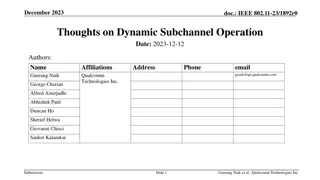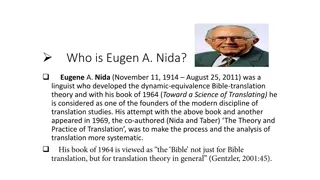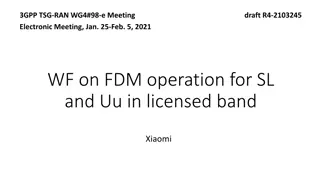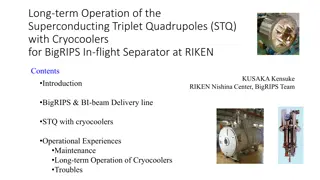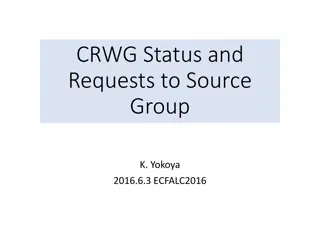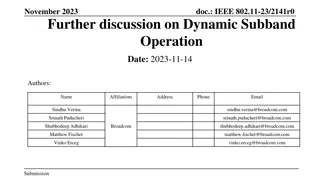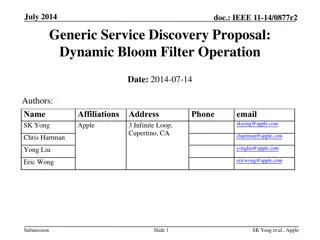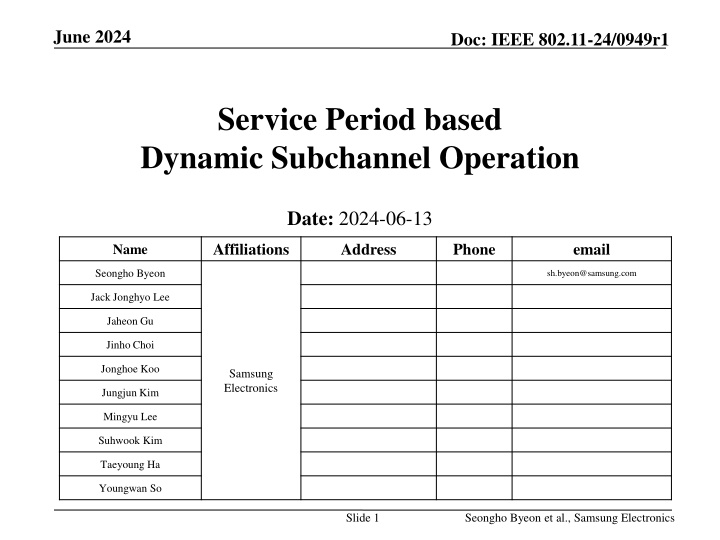
Efficient Dynamic Subchannel Operation in IEEE 802.11-24: Insights by Samsung Electronics
Explore the efficient use of operational bandwidth through Dynamic Subchannel Operation (DSO) in IEEE 802.11-24 standard, focusing on optimizing spectral efficiency and resource allocation. Samsung Electronics provides valuable insights on DSO implementation, including considerations, overhead challenges, and benefits for improved Wi-Fi performance.
Download Presentation

Please find below an Image/Link to download the presentation.
The content on the website is provided AS IS for your information and personal use only. It may not be sold, licensed, or shared on other websites without obtaining consent from the author. If you encounter any issues during the download, it is possible that the publisher has removed the file from their server.
You are allowed to download the files provided on this website for personal or commercial use, subject to the condition that they are used lawfully. All files are the property of their respective owners.
The content on the website is provided AS IS for your information and personal use only. It may not be sold, licensed, or shared on other websites without obtaining consent from the author.
E N D
Presentation Transcript
June 2024 Doc: IEEE 802.11-24/0949r1 Service Period based Dynamic Subchannel Operation Date: 2024-06-13 Affiliations Address Phone email Name Seongho Byeon sh.byeon@samsung.com Jack Jonghyo Lee Jaheon Gu Jinho Choi Jonghoe Koo Samsung Electronics Jungjun Kim Mingyu Lee Suhwook Kim Taeyoung Ha Youngwan So Slide 1 Seongho Byeon et al., Samsung Electronics
June 2024 Doc: IEEE 802.11-24/0949r1 Introduction One of main objectives for UHR PAR At least one mode of operation capable of improving efficient use of the medium Many Wi-Fi STAs do not support the full bandwidth option supported by the AP While APs may support up to 320 MHz, STAs may support only 80 MHz or 160 MHz Large portions of the operational bandwidth go underutilized, leading to poor spectral efficiency [RECAP] Dynamic Subband/Subchannel Operation (DSO) discussed in TGbn An AP can dynamically allocate different parts of subchannels within its operating bandwidth to non-AP STAs depending on their operating bandwidth capabilities, channel conditions and QoS requirements within a TXOP [1-6] Slide 2 Seongho Byeon et al., Samsung Electronics
June 2024 Doc: IEEE 802.11-24/0949r1 Introduction General considerations on DSO An AP indicates to DSO STAs the subchannel on which they will be served within the TXOP in advance The AP initiates a TXOP and sends control frames (i.e., DSO ICF) to DSO STAs in order to provide a sufficient time, allowing them to perform the channel switch Mode of operation and required signaling: Enabling or disabling DSO mode, DSO subchannel, DSO switching latency capability, etc. Intermediate FCS for DSO ICF, depending on DSO STA s switching latency [7] Second control frame for operation verification of DSO STA At the end of the TXOP, DSO STAs switch back to the primary channel Slide 3 Seongho Byeon et al., Samsung Electronics
June 2024 Doc: IEEE 802.11-24/0949r1 Some Thoughts on DSO Operating bandwidth switching overhead [8] Expected padding delay required for DSO STAs: 80MHz+ devices: 32-64 ?s & 20MHz only devices: 500-1000 ?s In multi-user transmission, the required padding may be the largest among all the DSO STAs served Some thoughts on TXOP-based DSO Discomforts for obtaining high efficiency Further usage of resources Intermediate-FCS and/or extra padding is required for the DSO ICF Additional frame exchange overhead (i.e., Second control frame and response to check whether DSO STAs change their operating bandwidth successfully or not) may be required in addition to DSO ICF Transition delay at the end of DSO when DSO STA moves its radio back on the primary channel Additional power consumption of DSO STAs is expected due to operating bandwidth switching Difficulty of fitting UL Target Received Power and CFO requirement [5] Due to the aperiodic operating bandwidth change of DSO STA, the complexity of channel estimation (i.e., MCS selection), MIMO operation (i.e., lack of sounding reference) or interference management increases If there is hidden interference outside the operating bandwidth of DSO STAs, a race condition may occur within the TXOP Slide 4 Seongho Byeon et al., Samsung Electronics
June 2024 Concept of Service Period (SP) based DSO Doc: IEEE 802.11-24/0949r1 Add HE SST functionality to the existing Broadcast TWT SP-based DSO Each STA completes the operating bandwidth switching by the start point of the Broadcast (R-)TWT SP (NOTE: Nothing changes for the STAs which have 160 MHz operating bandwidth) Trigger frame (e.g., MU-RTS, BSRP w/ UORA, Basic Trigger, etc.) can be used to confirm the awake status of associated STAs and the subchannel on which the STAs stay Trigger-enabled Broadcast (R-)TWT SP Broadcast TWT 1 S160 M- STA BA M- STA BA AP Basic TF DL MU PPDU Basic TF (320 MHz) P160 Beacon Broadcast TWT IE TB PPDU DSO STA1 AID 8 (160 MHz) S160 doze PS-P BA After receiving the Broadcast (R-)TWT IE, STA1 transitions to the awake state exactly when the service period arrives and completes changing the operating bandwidth to S160 At the end of the SP, STA1 transitions to the doze state. For the next TBTT and corresponding awake state, it may configure the operating bandwidth set as P160 to receive Beacon P160 DSO STA2 AID 9 (160 MHz) S160 doze TB PPDU P160 QoS N BA Slide 5 Seongho Byeon et al., Samsung Electronics
June 2024 Doc: IEEE 802.11-24/0949r1 Further Details of SP-based DSO AP operates DSO within its (R-)TWT SP: Example of configuration of DSO information subfield Nominal Minimum TWT Wake Duration TWT Wake Interval Mantissa Restricted TWT Traffic Info (optional) Target Wake Time Broadcast TWT Info DSO Info (optional) Request Type Octets: 2 2 2 2 2 0 or 3 0 or n Extension of Figure 9-790 -- Broadcast TWT Parameter Set field format Subchannel pool DSO on/off notification per Broadcast (R-)TWT SP DSO scheduling info in an individually assigned User Info field STA can switch its operating bandwidth voluntarily or forcibly Each DSO STA can move to a randomly selected subchannel among candidates in the subchannel pool announced by the DSO Info field Or AP can assign subchannel(s) individually to each DSO STA Long-term: (Re)association response, probe response, or (unsolicited) TWT response frame Short-term: Broadcast TWT Parameter Set field format (individually assigned User Info field for DSO scheduling) Slide 6 Seongho Byeon et al., Samsung Electronics
June 2024 Doc: IEEE 802.11-24/0949r1 Further Details of SP-based DSO Advantages of SP-based DSO Through an increase in the efficiency of bandwidth utilization, the quality of service (QoS) requirements for R-TWT members can be more easily achieved Since STAs finish setting up the operating bandwidth at the start point of the SP, there is no waste of resources caused by the switching delay within the TXOP Similarly, when the STA wakes up from the doze state to the awake state, it sets up the operating bandwidth to be used during the SP, so that no additional power consumption due to frequent changes in the operating bandwidth does occur DSO can be effectively managed with just a few necessary pieces of information field added to the R- TWT framework, thus minimizing the amount of signaling overhead required At the beginning of the SP, the operating bandwidth switch has been completed, making it possible to achieve calibration easily, using a single ICF like the MU-RTS or BSRP/Basic Trigger frames Especially good combination w/ the trigger-based TXOP Easy to check DSO operation and awake state simultaneously using tools like UORA (Optional) If OBSS PPDU or TXOP is observed in the primary channel during the R-TWT SP, non- primary channel access (NPCA) can be easily applied Slide 7 Seongho Byeon et al., Samsung Electronics
June 2024 Doc: IEEE 802.11-24/0949r1 Conclusion In this presentation, we propose a Service Period based Dynamic Subchannel Operation (SP-based DSO), harnessing the combined potential of HE SST and Broadcast TWT This allows the AP to provide a simpler and easier way to improve the efficient use of medium The proposed SP-based DSO can coexist independently with DSO operating on a TXOP basis Slide 8 Seongho Byeon et al., Samsung Electronics
June 2024 Doc: IEEE 802.11-24/0949r1 Straw Poll Do you support to define a mechanism in 11bn, enabling resource allocations to non-AP STAs beyond their current operational bandwidth and within the associated AP's BSS bandwidth on a per Broadcast TWT Service Period basis? Y / N / A Slide 9 Seongho Byeon et al., Samsung Electronics
June 2024 Doc: IEEE 802.11-24/0949r1 References [1] 11-23/2141r3 Further Discussion on Dynamic Subband Operation (Sindhu Verma, Broadcom) [2] 11-23/2027r2 Considerations for DSO Sub-band switch delay (Vishnu Ratnam, Samsung) [3] 11-23/1892r0 Thoughts on Dynamic Subchannel Operation (Gaurang Naik, Qualcomm) [4] 11-24/0449r3 Considerations on Dynamic Subchannel Operation Follow (Liuming Lu, OPPO) [5] 11-24/0299r1 Initial ctrl frame for BW switching modes (Vishnu Ratnam, Samsung) [6] 11-24/0493r2 Dynamic Channel Switch Operation (Liwen Chu, NXP) [7] 11-24/0171r8 TGbn Motions List Part 1 (Alfred Asterjadhi, Qualcomm) [8] 11-24/0517r0 Pre-allocation of sub-band for DSO follow up (Vishnu Ratnam, Samsung) Slide 10 Seongho Byeon et al., Samsung Electronics
June 2024 Doc: IEEE 802.11-24/0949r1 Backup Slide 11 Seongho Byeon et al., Samsung Electronics
June 2024 Doc: IEEE 802.11-24/0949r1 Recap [11ax] HE SST using Individual TWT HE subchannel selective transmission (SST) operation SST setup by negotiation of individual TWT An HE SST non-AP STA and an HE SST AP set up SST operation by negotiating a individual trigger-enabled TWT TWT Channel field composed of 8 bits (each of 20 MHz channels) of the TWT element is used to indicate the secondary channel in TWT request/response Frame exchanges during SPs HE SST AP allocates individually addressed RUs to the HE SST non-AP STA that are within the subchannel(s) indicated in the TWT Channel field of the TWT response HE SST non-AP STA is available in the subchannel(s) indicated in the negotiated TWT Channel field at TWT SP start [11be] Restricted TWT (R-TWT) Restricted TWT: Trigger-enabled Broadcast TWT operation To minimize medium contention and allow power saving STAs to reduce power consumption by explicitly identifying the time periods when they should be awake A non-AP EHT STA as a TXOP holder shall ensure the TXOP ends before the start time of any active R-TWT SPs Slide 12 Seongho Byeon et al., Samsung Electronics

